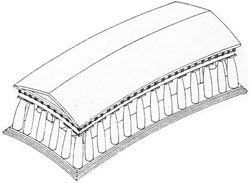The Parthenon
Refinements
a) One major innovation of the Parthenon was its mixture of Doric and Ionic elements. While the external structures of the temple were Doric, the central structures of the temple made use of Ionic elements. A sculptured Ionic frieze encircled the whole of the cella and replaced the Doric frieze over the pronaos and opisthodomos and the treasury contained tall, thin Ionic columns. In addition, all 92 of the external Doric metopes were decorated with architectural sculpture.
 b) Another major innovation was the use of several optical refinements. In no other ancient building was the complexity of optical correction carried to such an intricate extreme.
b) Another major innovation was the use of several optical refinements. In no other ancient building was the complexity of optical correction carried to such an intricate extreme.
1) Inclination (the inward tilt) of the columns created the illusion of perspective in the building's elevation. All the other vertical elements of the temple including the long walls of the cella also inclined in sympathy with the peristyle.
2) The spacing between the columns at the corners was contracted. This created the illusion of horizontal perspective on the facades, and on the Parthenon this was repeated in the triplyph frieze in the contraction of the metopes next to the corner triglyphs.
3) The barely perceptible entasis (swelling) of the column shafts created an illusion of straight, upright columns.
4) The floor of the temple (stylobate) and the surface of the steps were also curved in a convex manner. Every horizontal element of the temple displayed the same convexity: the architrave, frieze, cornice.
Parthenon: Introduction < Previous | Next > Parthenon: Decoration